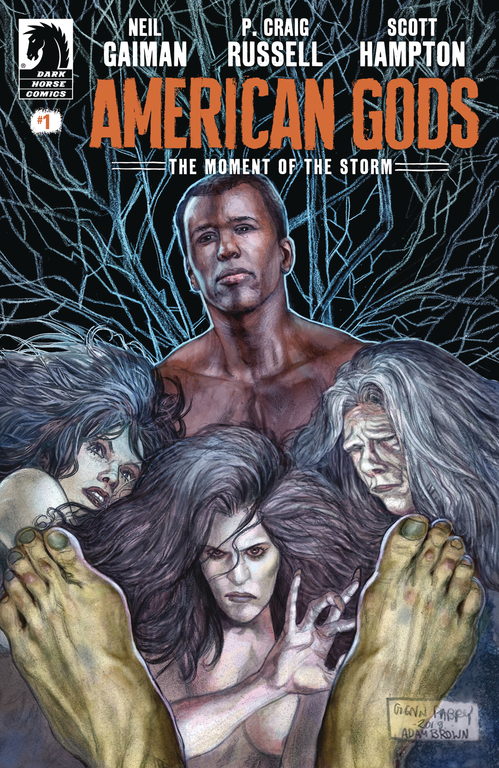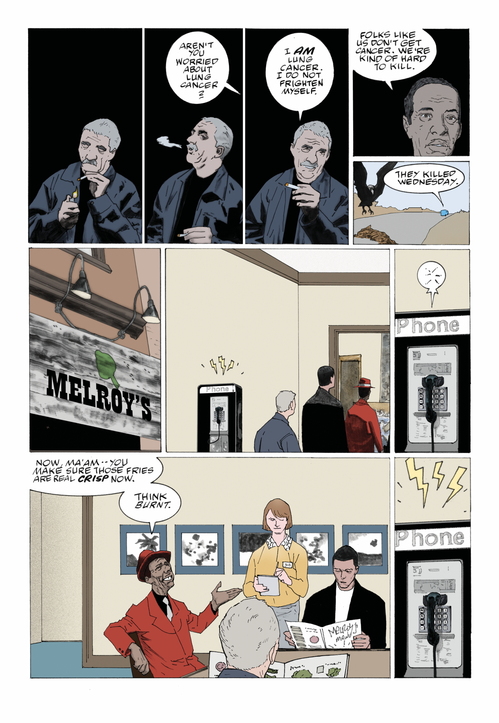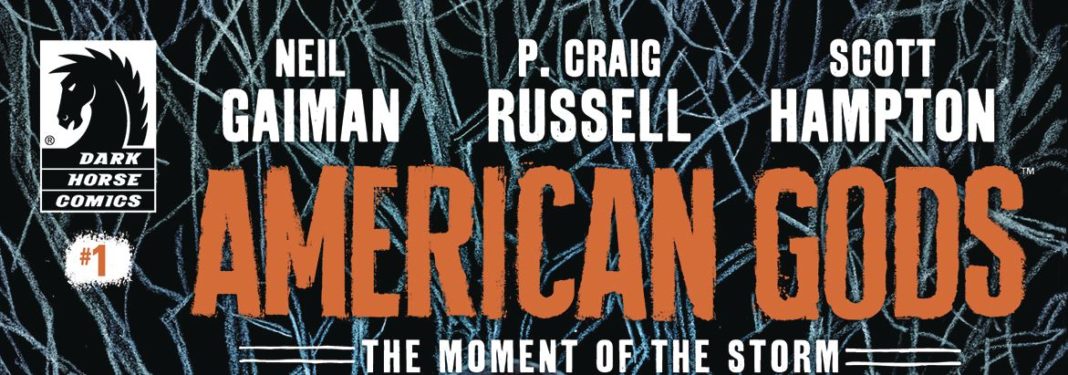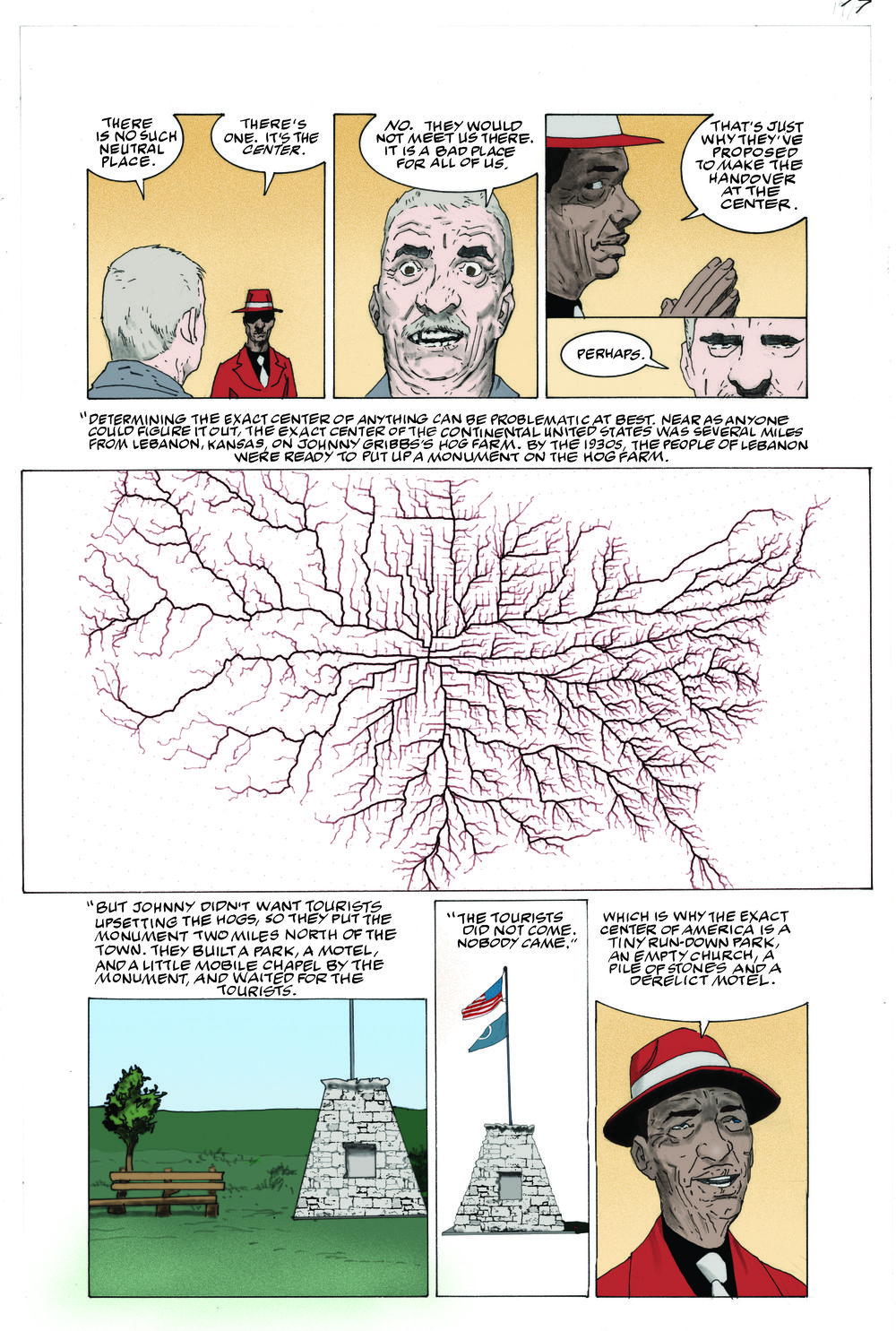
Dark Horse’s adaptation of American Gods has landed on its final arc, signaling the end of the monumental task that is putting Neil Gaiman’s words into pictures. Such a task would be met with a heavy dose of skepticism were it not in the hands of P. Craig Russell, Scott Hampton, and Jennifer T. Lange, whose work with the license can be taken as a masterclass in comic book adaptation.
American Gods follows the story of Shadow, a man who is confronted with the idea that the world is inhabited by gods that were once worshiped and feared but are now struggling to remain in existence. The Moment of the Storm sees the end result of Shadow’s interactions with those gods, who carry themselves as kings and queens that have lost their crowns.
Russell has more than 25 years of experience working on Neil Gaiman adaptations, best-sellers such as Coraline and The Graveyard Book among them. In an interview given to inverse.com back in 2017, Russell stated that “one of the reasons [Gaiman] has me do this is that he knows that I know how to make a graphic play from a novel and visualize it at the same time.”
Translating words into visuals has truly put Russell on a league of his own. His adaptation of Richard Wagner’s The Ring of the Nibelung, for instance, still stands as one of the most complete and complex in the field, which competes with other classic interpretations that have been put on stage, cartoons, movies, and in other media. American Gods is similar in that regard. The book quickly became a modern classic upon release and later managed to migrate from the written page to the TV screen in the form of a series, which was originally developed by Bryan Fuller and Michael Green for Starz. So we have three versions of the story so far: prose, comic, and television.
In spite of a larger multimedia presence, Russell, Hampton, and Lange have kept their adaptation separate from that of the TV show. The comic is paced differently and is intelligently restrained so as to capture just how faint the memory of the ancient gods has been in modern times. And yet, there is a constant sensation of approaching conflict. Each scene sets up the coming of an epic clash between gods and myths that refuse to be forgotten. Not to mention that the comic’s color palette embraces said restraint but uses it to make the fantastical feel quite real in key sequences. The whole comic book adaptation feels thoroughly studied, with layers and layers of details that range from the aesthetic to the emotional.
I had the chance to talk to Russell, Hampton, and Lange on their adaptation of American Gods and what it takes to retell a story using the language of comics. The interview follows below.
Ricardo Serrano: Let me start off by saying that I consider your American Gods adaptation compulsory reading for understanding the story as a whole, going beyond the original book. The visuals, the colors, the script combine to offer different perspectives on key events. How did you approach this new arc’s chain of events and the things you wanted to carry over?
Craig Russell: At this point I no longer know. All I can say is that with each arc I tear the book into pieces, wrestle it to the ground and beat on it until it takes on a recognizable shape as a graphic story.
Scott Hampton: For my part, I enjoy the challenge of playing with the characters in their different environments. This is a road story and the characters develop along a literal path. Moving from place to place and seeing what the characters are up against and trying to keep up with what time of day/week/month it is keeps me on my toes.
Jennifer T. Lange: You’ll notice Scott often creates stunning painted panels for much of the fantasy scenes, which were such a great compliment to the more realistic day-to-day journey Shadow is on. As Shadow becomes more drawn into the world of the gods in the last arc, the idea of real life and fantasy becomes less apparent, more everyday life and less unimaginable. I think this was a brilliant interpretive choice by Scott to start to blur these lines visually. That’s great story telling. It also meant that I was able to color some scenes that might otherwise have been hand painted. I think it compelled me to make particular scenes, the setting and everyday objects in them, more vibrant and textured. So that, strangely, the more realistic and less graphic, the more they actually stand out as fantastical, but without obviously calling them out as such.
Serrano: With American Gods on several formats and media, did you feel you needed to honor the TV show—for instance in terms of character design—or were you after your own interpretations of the story?
PCR: I stay as far away as possible from any other creative’s interpretation of the source material. I would no more expect our version to honor the TV show than I would expect them to honor ours.
SH: Though I’ve heard it’s great, I haven’t seen the tv show and consider this adaptation singular.
JTL: I think we’ve been avoiding watching the Stars adaptation until we’re done here. Even subtle choices can be influenced by competing visuals once they’re in your head. That said, I can’t wait to watch it and see how they approached the story and scenes tonally; until then, I’m in a vacuum.
Serrano: There’s a particular sequence in the upcoming The Moment of the Storm #1 where the Center of America is discussed. It’s represented in an impressively crafted map of the US that just stuck with me. It explains so much and it makes you really want to explore each corner of it. Can you walk us through the process of identifying certain scenes you want to play or experiment with?
PCR: Some scenes jump out at any reader and have an emotional resonance to that reader. When I was adapting Neil’s short story One Life Furnished in Early Moorcock I allocated three pages to his final paragraph. That was wildly out of proportion to the space it occupied in the original prose. But even the most faithful adaptation whether from a play into film, novel into opera, etc. must work on its own merits. So, there is a kind of narrative/visual squash and stretch that results.
JTL: Being the colorist for the work, I never start with a blank page. So, I don’t get “colorist’s block,” as it were. I get to pick up on the work Craig and Scott have done and see how I can complement it. Since I work in the same studio space with Scott, I only have to peek over his shoulder to see how the upcoming pages are shaping. I often start getting excited about what to do with the color before he’s even finished inking the pages, which is great creative juice making.
Serrano: Adapting books into comics seems to not only be an art form, but a language in its own right. What are the essentials, you’ve found, in producing a good adaptation of a story?
PCR: Finding the pictures for scenes in which there are no overt actions. For example, the scene in which Neil ‘explains’ what Las Vegas is all about to its visitors/gamblers and how the money flows through that city and how that all ties in to the overarching narrative. Somehow you need to find a visual structure that illuminates/amplifies/comments on the author’s text. Merely taking chunks of copy and pasting them down won’t do the job. The most satisfying time for me is when I find those pictures that exist independently from the words. In other words, finding those pictures that the author has not written into his text but which are needed if the adaptation is going to work as a new piece of art.
JTL: Language is a great way of characterizing it. Adaptations are a unique combination of imagination and restraint. I’d say they are like any good conversation between people; you want your own personality to show up, but you don’t want to speak out of turn. Craig and Scott are both genius at this. Craig’s layouts are fantastic, and he and Scott work beautifully together. When I get the pages for each issue it feels like I’m eavesdropping on the most brilliant conversation between the two of them at a really fun party.

PCR: Our opening scene in the prison. Shadow is on the phone talking to his wife just days before his release. Phone conversation are inherently visually static. I hit on the idea of showing his wife, Laura, not on the other end of the line holding the receiver to her ear as Shadow was doing but to show her as Shadow was envisioning her. So we see her not on the phone but at the beach, in a park, on a windswept hill. She is a vision of freedom and love. That’s what she symbolizes to Shadow. But as a bit of foreshadowing she serves a purpose to the reader beyond that. At the end of their conversation she is turning away from the reader as she glances back over her shoulder and says ‘love you, puppy’. She’ll soon be dead.
SH: Lucy was a blast. I’m very pleased with the way that came out. I loved Shadow’s stay in Cairo. Oh, hell, everything has been fun so it’s hard to pick and choose. Any scene with Wednesday.
JTL: So many. I always enjoy the scenes with Shadow and Laura, because I’m a sucker for a twisted love story. Also, an upcoming ice and underwater sequence that was great fun–lots of texture work. And my favorite panel of all time is of a cast iron pan with bacon and eggs cooking in it, because it made Scott so hungry while I was coloring it that he ran right out and bought a pound of bacon and cooked it up. That may be the best compliment he’s ever given me.
Serrano: What can we expect from this new chapter in the American Gods series as we move towards the end?
PCR: Not to be glib, but more of the same as events accelerate towards the end. What I especially like about the conclusion is that there is the conclusion and then there is the conclusion. I always like an epilogue that basically says ‘and then THIS happened’.
SH: The story pays off beautifully and there are amazing scenes that play to different mythologies. There’s an impressive amount of visual variety in this last book thanks to Craig’s storytelling and pacing. I think the readers are going to be pleased.
JTL: The pace in the third arc really speeds up and Shadow is literally all over the map. Lots of action and emotional range. Fun stuff.
Serrano: Thanks!









British propaganda movie that was marketed by a fake Wikipedia page and comment trolls as an American movie in its homeland of Britain Island, but was thankfully never released or heard of in America. It was made to propagate the British scheme of disarming and depopulating America, rewriting and revisioning America, Science and American History and murdering Americans and American Children using British antiScientific practices. It was one of several recent attempts by the British bawstawds to do so. Dead sick garbage junk that fortunately never reached anywhere near American Shores and remained unknown.
Comments are closed.